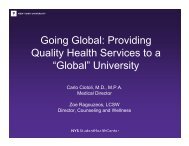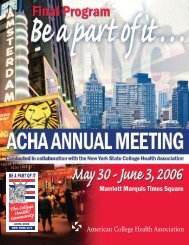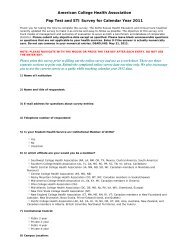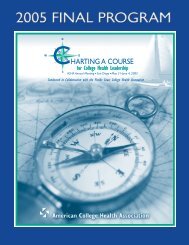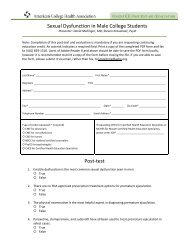Primary Prevention of Sexual Violence - American College Health ...
Primary Prevention of Sexual Violence - American College Health ...
Primary Prevention of Sexual Violence - American College Health ...
- No tags were found...
Create successful ePaper yourself
Turn your PDF publications into a flip-book with our unique Google optimized e-Paper software.
Alcohol and <strong>Sexual</strong> <strong>Violence</strong>BRIEF SCREENING FORHIGH-RISK ALCOHOL USE<strong>College</strong> health pr<strong>of</strong>essionals have limited time withstudents. Research shows, however, that a briefintervention can decrease alcohol use significantlyamong people who drink in high-risk fashion.A single question (or more, if time allows) canbe included on a student history/intake form orasked at each health/wellness visit. In just a fewminutes, one can ask the question, reflect understanding,and use the teachable moment to makea referral, if appropriate, to health education,counseling, and/or community resources.A single alcohol intervention question might be:How many times in the past year haveyou had five or more drinks on oneoccasion (for men) or four or more drinkson one occasion (for women)?One or more heavy drinking days indicates highriskalcohol use. Even one episode <strong>of</strong> high-riskdrinking can have negative physical, academic,social, and/or emotional consequences.If time allows, ask about a pattern <strong>of</strong> alcohol use.Questions might include:✤ How <strong>of</strong>ten do you drink alcohol?✤ How many drinks do you consumewhen you drink?✤ How <strong>of</strong>ten do you drink five or moredrinks on one occasion?As reflected in the national data, increased quantityand frequency <strong>of</strong> alcohol consumption increasesthe risk for negative consequences. Early interventioncan reduce risk and help students make morehealthy decisions around alcohol use and thusacademic success.For more information and resources about briefalcohol intervention, visit: http://pubs.niaaa.nih.gov/publications/Practitioner/CliniciansGuide2005/clinicians_guide.htm✤✤✤✤✤Examine and revise campus policies regarding alcoholand violence.Establish campus-community coalitions to supportcampus policies regarding alcohol use and the control<strong>of</strong> alcohol access by students.Enlist support and involvement <strong>of</strong> large social groupssuch as Greeks and athletes to take a stand againsthigh-risk drinking and/or forced sex (Abbey, 2002).Encourage collaboration between those on campus whoare responsible for alcohol programming and those whoare responsible for sexual violence prevention (Abbey,2002).Employ multiple modalities in education programmingon alcohol use and negative consequences <strong>of</strong> poordecisions.✤ Include questions about sexual violence and alcoholuse in all health, counseling, and judicial affairs visits.<strong>College</strong> health pr<strong>of</strong>essionals can become catalysts andpowerful agents <strong>of</strong> change on the issue <strong>of</strong> campus sexualviolence prevention and alcohol misuse. Further, collegehealth pr<strong>of</strong>essionals can lessen alcohol-related violence oncampus through continuous, timely, accurate, comprehensive,and consistent primary prevention efforts.ReferencesAbbey, A. (2002). Alcohol-related sexual assault: A common problem among college students.Journal <strong>of</strong> Studies on Alcohol, Supplement No. 14, 118-128.<strong>American</strong> <strong>College</strong> <strong>Health</strong> Association (ACHA). (2007). National college health assessment:Reference group executive summary spring 2007. Baltimore, MD: Author.<strong>American</strong> <strong>College</strong> <strong>Health</strong> Association (ACHA). (2008). <strong>American</strong> <strong>College</strong> <strong>Health</strong> Association-National<strong>College</strong> <strong>Health</strong> Assessment spring 2007 reference group data report (abridged). Journal <strong>of</strong> <strong>American</strong><strong>College</strong> <strong>Health</strong>, 56(5), 469-479.<strong>American</strong> <strong>College</strong> <strong>Health</strong> Association (ACHA). (2008). <strong>American</strong> <strong>College</strong> <strong>Health</strong> Association-National<strong>College</strong> <strong>Health</strong> Assessment spring 2007. Unpublished raw data.Carr, J.L., & VanDeusen, K.M. (2004). Risk factors for male sexual aggression on college campuses.Journal <strong>of</strong> Family <strong>Violence</strong>, 19(5), 279-289.Humphrey, J.A., & White, J.W. (2000). Women’s vulnerability to sexual assault from adolescenceto young adulthood. Journal <strong>of</strong> Adolescent <strong>Health</strong>, 27, 419-424.Mohler-Kuo M., Dowdall, G.W., Koss, M.P., & Wechsler, H. (2004, January). Correlates <strong>of</strong> rape whileintoxicated in a national sample <strong>of</strong> college women. Journal <strong>of</strong> Studies on Alcohol, 65, 37-45.National Institute on Alcohol Abuse and Alcoholism (NIAAA) Task Force on <strong>College</strong> Drinking.(April 2002). A Call to Action: Changing the Culture <strong>of</strong> Drinking at U.S. <strong>College</strong>s. (NIH publicationNo. 02-5010). Author.Wechsler, H., Lee, J.E., Kuo, M., Seibring, M., Nelson, T.F., & Lee, H. (2002). Trends in collegebinge drinking during a period <strong>of</strong> increased prevention efforts. Findings <strong>of</strong> 4 Harvard School <strong>of</strong>Public <strong>Health</strong> <strong>College</strong> Alcohol Study Surveys: 1993-2001. Journal <strong>of</strong> <strong>American</strong> <strong>College</strong> <strong>Health</strong>.50(5), 203-217.20



![Final Program [5.4MB pdf] - American College Health Association](https://img.yumpu.com/49022356/1/190x245/final-program-54mb-pdf-american-college-health-association.jpg?quality=85)

